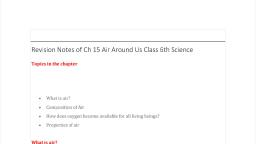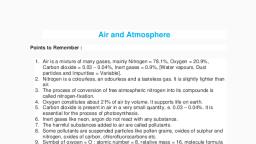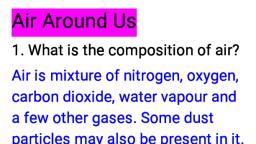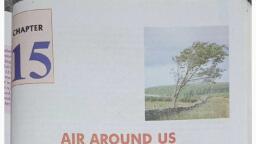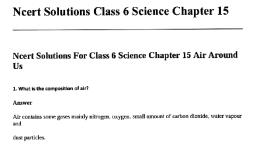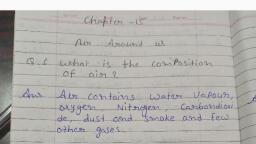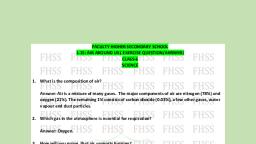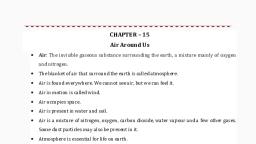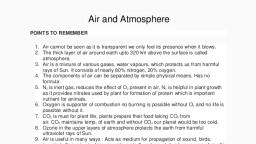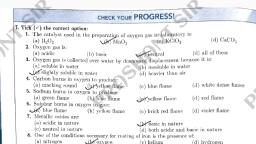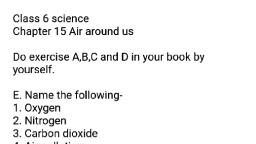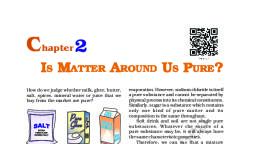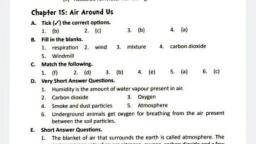Page 1 :
Mor the br i ig thing iving things,, t We can live without food and water for a few days but we cannot live for more, ; minutes without air. Air is present on the ground, on the top of trees and buildings as well as, igh up in the sky. Air is present in the soil. Some air is prese even in the water of ponds, lakes, rivers:, , , , , , , , Though we cannot, , S: ind. Moving air makes the clothes hanging on a cloth line sway: And the air blowing ina, arden stirs the leaves and branches of trees. When a fan is switched on, the air moved by the blades of the, makes the pages of an open book flutter back and forth. It is the moving air which makes it possible, us to fly a kite in the sky (by pushing against it). ‘And it is also the moving air which pushes the sails, yacht (sailing boat) and makes it move in water. In agriculture, moving air helps us separate husk from, N heat grains during winnowing. High speed, , winds can even uproot the trees and blow off, e tin roofs of houses and factories., , We have seen many little children playing, with “phirki” (wind-vane). When a child holds, the stick of the phirki in his hand, stands in an, ‘open area and adjusts the direction of phirki, blade, the phirki starts rotating (see Figure 1). It, is the moving air (or blowing air) which makes, a phirki rotate. Another device which works, by utilising the moving air is weathercock. In, a weathercock, a proad blade in the shape ofa, cock is fixed on an arrow which is attached to a =, rotating axis (see Figure 2). When the moving figure 1. A phirki (wind-vane). Figure 2, A weathercock., , 231, , , , see air but we can feel its presence when it starts moving (or blowing). Moving: J, , , , und us; All), , 4, , a
Page 2 :
J, a, , air pushes ", the cock blade, then the cock and its arrow rotate and align in the direction of moving air, Th, a tS 2 device which shows the direction in which the ait is moving (or blowing) ata Place, $s Wansparent, so we can see through it. A ‘iteSinee air | :, , ir RUS, . MN i, Speen nbs compresed easy When we fill’ a foot Madde 1 bic ‘let tbe wit, ma ve '¥ COMPTESS air_ important properties of air are as follows ;, , , , , , , , , jo, , , , , , , , , , , , , , , , , , , , , , , , , , , , , , , , , Same mEven when we an empty le upside down, the air Semainié in it We can show 0, performing @ simple activity that air occupies space and that even an empty bottle is full of air, “Bime, ( 7 ACTIVITY P, ‘We take an empty glass boitle and hold it in the inverted position (with its open mouth facing down, ‘The inverted glass bottle is put in water kept in a vessel [as shown in Figure 3(a)]. We will find that Watet a, does not enter into the inverted glass bottle. The water does not enter into the glass bottle because the bottle ME =, f wath air. Actually, all the space in the bottle is occupied by air. The air present in the empty glass 3, be Prevents the water from entering it. From this activity we conclude that air occupies space., 4, wr Water, e!, ag), Figure 3. ‘kk :, j lf we tilt the bottle held in water, we will find that the air p), ‘present in the bottle goes out in the form of air bubbles [see Figure ae, 316). As the air irom the bottle escapes, water starts entering the ha, Blass bottle. Actually, the space vacated by the air leaving the Att, bottle is now occupied by water. The above activity shows that, a bottle which appears to be empty to us is actually filled, ig, ", , , , ia i iv kilome, an We live within the atmosphere of the earth "Atmospheres /Figure 4. The envelope of air around the earth, , y is called atmosphere. 1, cl
Page 3 :
233, , , , , ig Organisms including us..As we go higher up in the, ess. The air at the top of very high mountains is so thin, Yygen for the people to breathe properly. So, the people who climb high, , mintains (called Mountaineers) carry cylinders containing oxygen gas with them. They breathe in oxygen, i these cylinders (so as to survive on high mountains)., , COMPOSITION OF AIR, , We will now describe what air is made up of. This is ‘called composition of air, We know that air is a, For a long time, people thought that air was just a single gas. Tt has now been proved by experiments, air is not a single gas. Airis a mixture of many gases, The major component of air is nitrogen gas., most four-fifths of air is nitrogen 88. The second major component of air is oxygen gas. About one-fifth, is oxygen gas. In addition to nitrogen and Oxygen gases, air also contains small amounts of carbon, pxide gas, water Vapour and some other Sases (Such as argon and helium, ete.) The air may also contain, composition of air as follows : Air is mainly a mixture of, , e dust particles. We can now describe the, frogen and oxygen gases with small amounts of carbon dioxide gas, water vapour and other gases,, ir. The composition of air in terms of percentage of its various, , here, the amount of air becomes less and 1, pt it does not have enough ox, , , , , , , , , , , , , , , , , , , , ame dust particles may also be present in ai, mponents can be written as follows :, Composition of Air, 1. Nitrogen : 78 percent, 2 Oxygen : 21 per cent, 3. Carbon dioxide, : 1 per cent, Water vapour,, Other gases, and, Dust particles, Thus, air contains mainly nitrogen and oxygen gases, In fact,, trogen and oxygen gases, taken together, make up about 99 per, ent of air (78 per cent + 21 per cent = 99 per cent), The remaining, Fper cent of air consists of carbon dioxide as, water vapour, a few, fther gases and some dust particles. Moan oxi ompereier ie, The composition of air can also be represented with the help of a Figure 5. Composition of air,, gram as shown in Figure 5. The composition.of air.is not always, stly the same, The composition of air changes slightly from place, 0 place and season to season. For example, the air over industrial cities usually has a higher amount of, dioxide in it than the air over open spaces. The air in coastal areas may have more water vapour, inland areas. The air also contains more water vapour in rainy season. Similarly, the amount of dust, n the air is more in windy places than other areas., , ACTIVITY TO SHOW THAT AIR IS A MIXTURE OF GASES, , ib, a8 of vessel) and place a gas jar stand in it. Fix a candle on the gas jar stand, ee ese aah water. oe some caustic soda (sodium hydroxide) in this water, ball ution. Also add a few drops of ink in water to colour it. aa, activity, we light the candle with a matchstick. Cover the burning candle by placi in, , wer it [see Figure 6(a)]. 4, Cale ing and water rises up in the, amet SO ENE of air present
Page 4 :
Figure 6., , Gif) When the candle bums, then oxygen of air in the gas jar is used up and carbon dioxide gas js, formed. This carbon dioxide gas is absorbed (or dissolved) by the caustic a solution in oes — The, absorption of carbon dioxide gas by caustic soda solution creates a vacuum (low pressure) in the gas jar., Water rises up in the gas jar to fill this vacuum. pet ;, , (iv) Water in the gas jar rises to about one-fifth part of the volume of air initially present in the Bas jar, [see Figure 6(b)]. The volume of water risen in the gas jar is equal to the volume of oxygen present in the, air in the gas jar (which was consumed during the burning of candle). From this we conclude that about, , , , , , one-fifth of air is oxygen. The major part of air which is not used up by a burning candle and remains Let, behind in the gas jar is nitrogen. Since water does not rise in the remaining four-fifth part of the gas jar in ie ThE ‘, this activity, it shows that about four-fifths part of air is nitrogen. ,, We will now discuss all the components of air in detail. a ee a, NITROGEN i,, , as. Nitrogen gas is slightly soluble in water. Nitrogen, , en gas neither burns itself nor supports the process, n n. Nitrogen is a very unreactive gas. In this respect,, is a very reactive gas)., , or liv, , , , , , , D i make proteins. These proteins are used, by the plants for suman beings and other animals. Thus,, nitrogen is needed by plants to make proteins., , less gas. Oxygen gas is slightly soluble in water., ation); We can live for several days without food and water but we, die Very q i x e oxygen present in air is important for the living things. All, ing things need oxygen of air for breathing., , , , , , , , , coal, kerosene, petrol and LPG. us, Oxygen supports life and, this in somewhat detail., , 1 is Necessary for Living Things, ig organisms breathe air to remain alive. So, air is necessary to sustain the life of all the, $: men, animals and plants. When a person breathes in air, it is actually the oxygen present in
Page 5 :
I, , which is utilized in the process of respiration. So, we can also say that oxygen, ys, Whether we say that air is necessary for breathing or oxygen is necessary for, same thing., , All the living things (animals and plants) use the oxygen of air for respiration. | 5, , yen bre own food : carbon dioxide, water and energy. This energy sustains the life of all the, jmals and plants. The animals and plants living on land take the oxygen required for breathing from, air around them. But the animals and plants living in water take the oxygen required for breathing, sm the air dissolved in water. We will now describe a simple activity to show that air (or oxygen) is, cessary for the survival of living things., , , , , , , , , , , , essai i, me, , breathing, it means, , , , , , , , , , , , , , , , , , , , , , , , , , ACTIVITY, , We take a small glass jar and put some food and water in it. A few living insects are caught and put in, glass jar. The mouth of glass jar is closed tightly by tying a polythene sheet around it. We will find that, sects gradually become inactive and die after a few days. This can be explained as follows: The closed, jar had air in it which contained some oxygen. This oxygen was used by the insects for breathing. After, ‘days all the oxygen of air in the closed glass jar was used up by the insects in breathing. Since no, n was left in the closed glass jar, the insects could not breathe any more and hence died. This activity, that air (or oxygen) is necessary for breathing and maintaining life., , , , , , _ Under ordinary conditions, we use the air around us for breathing purposes. But rs, ders are use: ions are, , , , , d breathing purposes. Three such special situati, an thi ties, a n + climbing high mountain and a div 8, Let us discuss all this in somewhat detail. . asada, , e component of air which is utilised in breathing (or respiration) is oxygen. The patients suffering, ‘diseases like asthma, etc., have sometimes difficulty in breathing properly in air because only onert of air is oxygen. Similarly, a patient undergoing a major surgical operation also has difficulty, thing properly in the surrounding air. So, oxygen gas is given to patients in hospitals who have, ity in breathing properly. All the hospitals have cylinders filled with oxygen gas for such patients., }) shows a patient being given oxygen gas from a cylinder in a hospital., , , , Mountaineer

